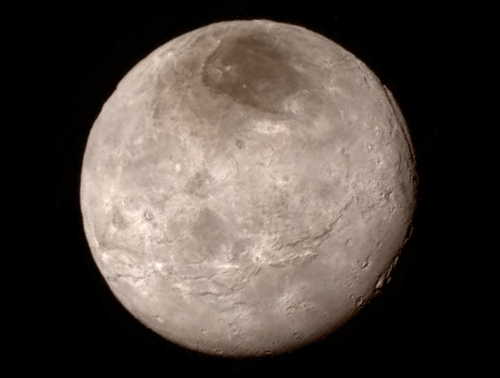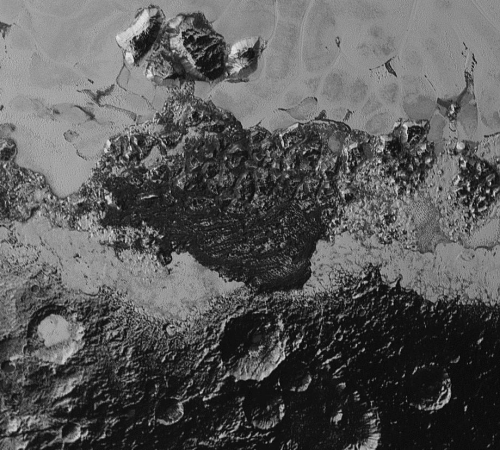Given the flow of new imagery from New Horizons, I began to realize that mission data were changing my prose. To be sure, I still lean to describing the system as Pluto/Charon, because given the relative size of the two bodies, this really seems like a binary object to me. I tend to call it a ‘binary planet’ among friends because I still think of Pluto as a planet, dwarf or not. But when New Horizons blew through the Pluto/Charon system, it was finally possible to start talking separately about Charon, because now we were seeing it, for the first time, up close.
Charon as a distinct object from Pluto is a fascinating thought, one I’ve mused over since the days of the smaller object’s discovery in 1978. An enormous moon hanging in the sky, never changing its position, over a landscape unknown — the imagination ran wild. In the event, New Horizons outdid anything I ever conceived, with imagery of both worlds we’ll be debating for a long time. But in some ways my favorite of the images so far is the one just below.

Image: Details of Pluto’s largest moon, Charon, are revealed in this image from New Horizons’ Long Range Reconnaissance Imager (LORRI), taken July 13, 2015, from a distance of 466,000 kilometers, combined with color information obtained by New Horizons’ Ralph instrument on the same day. The marking in Charon’s north polar region appears to be a thin deposit of dark material over a distinct, sharply bounded, angular feature; scientists expect to learn more by studying higher-resolution images still to come. (Credit: NASA/Johns Hopkins University Applied Physics Laboratory/Southwest Research Institute).
What’s striking about Charon at first glance is the darkening at the north pole, a phenomenon Carly Howett (Southwest Research Institute, Boulder) discussed in a recent blog article for NASA. Redder and darker it is, a circumstance Howett explains by reference to the surface composition of the northern polar region. A working theory is that traces of Pluto’s atmosphere reach Charon on occasion, where the gases come into contact with polar regions with temperatures between -258 and -213° C. This is a range not a lot higher than absolute zero (?273.15° C, or ?459.67° Fahrenheit).
Gases arriving at Charon’s winter pole would simply freeze rather than escaping, so we have a deposit of Pluto’s atmospheric nitrogen, with methane and carbon monoxide, gradually building up. This would not occur at Charon’s somewhat warmer equator. When the winter pole re-emerges into sunlight, solar radiation on these ices produces tholins, which form when simple organic compounds like methane are irradiated. With their higher sublimation temperature, these tholins cannot escape back into space. Howett sums it up this way:
Charon likely has gradually built up a polar deposit over millions of years as Pluto’s atmosphere slowly escapes, during which time the surface is being irradiated by the sun. It appears the conditions on Charon are right to form red tholins similar to those shown, although we have yet to figure out exactly why. This is one of the many things I am looking forward to better understanding as we receive more New Horizons data over the next year and analyze it in conjunction with continued laboratory work.
Tholin color depends on the ratios of the molecules involved and the kind of radiation received — various shades have been produced in the laboratory. We don’t find them on Earth outside of our own laboratories, but tholins are thought to be abundant on the icy objects in the outer system, usually taking on a reddish brown hue. You may recall they’ve also been discussed in relation to Titan, where we’ve learned from Cassini measurements that tholins appear higher in the atmosphere than was once believed (see Titan’s Tholins: Precursors of Life?). Think of them not as a single specific compound but a range of molecules with a generally reddish color.
Did tholin-rich comets play a role in delivering the precursor materials needed for life to develop on Earth? It’s a notion we can’t rule out, but for now what we can do is study tholins in the places they naturally occur, and in the case of Charon, we can see that they are part of a mechanism that can explain surface color variations. The object 28978 Ixion, a Kuiper Belt object in orbital resonance with Neptune, appears to be particularly rich in tholins.
Meanwhile, the flow of data from New Horizons in just the last few days has more than doubled what we can see of Pluto’s surface at the 400 meter per pixel level. We’re finding still more puzzles as we push deeper into the imagery, with features that appear to be dune-like, and what seem to be nitrogen ice flows and valleys that could have been carved by such flows over the surface. The processes at work should provide fodder for countless dissertations. Here’s one of the new images — for more, see New Pluto Images from New Horizons: It’s Complicated.

Image: This 350-kilometer wide view of Pluto from NASA’s New Horizons spacecraft illustrates the incredible diversity of surface reflectivities and geological landforms on the dwarf planet. The image includes dark, ancient heavily cratered terrain; bright, smooth geologically young terrain; assembled masses of mountains; and an enigmatic field of dark, aligned ridges that resemble dunes; its origin is under debate. The smallest visible features are 0.8 kilometers in size. This image was taken as New Horizons flew past Pluto on July 14, 2015, from a distance of 80,000 kilometers. Credit: NASA/Johns Hopkins University Applied Physics Laboratory/Southwest Research Institute.
“The surface of Pluto is every bit as complex as that of Mars,” said Jeff Moore, leader of the New Horizons Geology, Geophysics and Imaging (GGI) team at NASA’s Ames Research Center in Moffett Field, California. “The randomly jumbled mountains might be huge blocks of hard water ice floating within a vast, denser, softer deposit of frozen nitrogen within the region informally named Sputnik Planum.”
Heavily cratered terrain next to young icy plains, with the suggestion of dunes on a place whose atmosphere should be too thin to produce them. No wonder William McKinnon (Washington University, St. Louis) calls the latter a ‘head-scratcher.’ The surfaces of Pluto and Charon have delivered complexities galore, and we’re only now learning that Pluto’s atmospheric haze is far more complex than earlier thought, offering a twilight effect that helps light nightside terrain. “If an artist had painted this Pluto before our flyby, I probably would have called it over the top,” says New Horizons principal investigator Alan Stern, “but that’s what is actually there.”
And then there’s this (brought to my attention by Larry Klaes):
OMG! Pluto never disappoints. Who said a picture=1000 words? I just saw a new one worth maybe 1000 scientific papers! #OMG #Plutoflyby
— NewHorizons2015 (@NewHorizons2015) September 13, 2015



I do wonder why Charon has been ‘colorised’ a pink/beige colour — more like Pluto. It is known to be bluer — ie greyish.
Alan Stern has decided to tease us with the following quote from his Twitter account:
“OMG! Pluto never disappoints. Who said a picture=1000 words? I just saw a new one worth maybe 1000 scientific papers!”
Thankfully the Intertubes have remained calm and not gone into wild speculation mode, and certainly nothing about finding aliens.
https://twitter.com/newhorizons2015
Pluto’s small moon Nix is reddish, or has a big reddish spot. Could this also be the result of tholins? Data on the composition of Nix is on its way, so we may find out the answer. The word “tholin” was coined by the late, great Carl Sagan (from “tholos”, Greek for “sepia ink”).
I’d love to be proved wrong, but I don’t think the features on Pluto that look like dune fields are really dunes. They are something else that *looks* like dunes. But if they are really are dunes, then desert exploration pioneer Ralph Bagnold’s book “The Physics of Blown Sand and Desert Dunes” might find a new application on yet another world (after already having been used by NASA to study Martian sand dunes). Bagnold was involved in the search for the legendary Zerzura Oasis in the Libyan Desert (the true story behind the film “The English Patient”).
suggestion of dunes on a place whose atmosphere should be too thin to produce them.
Is is possible this indicates that Charon (and Pluto) may have had thicker atmospheres in the past?
This reference shows some structures experimentally determined in synthetic tholins. There is quite a wide variety, including the amines that could be part of amino acids. Funny to think that the Urey-Miller experiment was probably recreating tholins, rather than just the precursors of proteins that they were looking for to test the idea of abiogenic life creation.
@ David. A. Hardy: The caption mentions that the colour comes from the Ralph instrument, so I’d expect it to be ball-park accurate. It might be an averaged colour,with the majority of the disk being blue-er and a few small sections having quite strong red tones?
John: I think you’re right, on both counts.
I too hold a penchant for Charon. Being able to follow the whole late approach and flyby was amazing and I haven’t stopped drooling over those precious few images of Pluto but when Charon showed his remarkable features for the first time… well, a childhood wish was realized; being 7yrs old in ’78 I can vividly remember de-facing a couple of my astronomy books by adding in Charon and drawing lots of ‘?’-marks instead of craters. It still styx (groan, sorry) in my throat now.
Can’t wait for a ton more data over the coming year :D
The Planetary Society goes into its usual in-depth detail on the latest data releases from New Horizons:
http://www.planetary.org/blogs/emily-lakdawalla/2015/09151415-new-horizons-pluto-raws-20150911.html
I am surprised there are so few craters even with the resurfacing with ices. The number of craters can tell us a lot more about the history of where Pluto was formed and where the late heavy bombardment came from. It looks like Neptune was responsible for the late heavy bombardment but there should have been a large number of rock/snowballs thrown outwards as well to cause craters on the Pluto system. Perhaps Pluto was further out and migrated in or Neptune was closer to the sun when it happened. The crater rates could also tell us more about the population of the Kuiper belt over time.
Is this the image Alan Stern was OMGing about….
http://www.nasa.gov/feature/pluto-wows-in-spectacular-new-backlit-panorama
The new batch of images are stunning. Can’t wait for the naming of features to be made so that Pluto becomes a familiar world.
A very detailed piece on the New Horizons publicity machine:
http://www.scilogs.com/the-leap/a-peek-inside-the-pluto-public-relations-machine/
I guess the varying insolation as Pluto moves around its orbit may help make it such a dynamic place. This kind of varied terrain might be a common feature on eccentric planets with sufficiently volatile material available on their surfaces.
Now we need a mission to the “anti-Pluto”: (90482) Orcus.